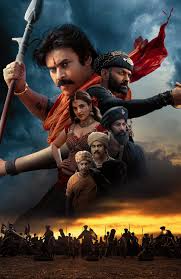Hari Hara Veera Mallu movie review: Pawan Kalyan’s epic is a long, loud misfire

When a star of Pawan Kalyan’s stature steps into a period epic like Hari Hara Veera Mallu, expectations skyrocket. Fans eagerly awaited a gripping tale of heroism, rich historical detail, and powerful performances, all wrapped in grandeur. Sadly, the film falls painfully short of delivering on these promises. Despite boasting lavish production values and a larger-than-life protagonist, Hari Hara Veera Mallu ends up as a lengthy, noisy spectacle that struggles to connect emotionally or narratively.
A Premise with Potential, Poorly Executed
The premise of Hari Hara Veera Mallu had everything going for it: a legendary rebel’s story set against a backdrop of political intrigue, colonial oppression, and cultural pride. The film sets out to celebrate bravery and defiance, telling the story of its titular hero’s fight against injustice. Unfortunately, a promising concept is buried beneath a convoluted screenplay that meanders endlessly without clear direction.
The script feels bloated, weighed down by unnecessary subplots and scenes that do little to advance the story. Instead of a tight, focused narrative, the film moves at a sluggish pace, often drifting into repetition. Moments that should have carried emotional weight feel hollow, and the film’s rhythm suffers from inconsistent editing choices. What should have been a taut, thrilling epic instead feels like a long slog.
Pawan Kalyan’s Presence: Charisma without Impact
Pawan Kalyan remains the film’s biggest asset. His charisma and screen presence are undeniable; when he’s on screen, he commands attention effortlessly. His portrayal of Hari Hara Veera Mallu showcases his trademark intensity and dedication. However, even a star of his caliber cannot fully salvage the film.
The character’s arc is underdeveloped, and the writing doesn’t give Pawan Kalyan enough emotional or psychological depth to explore. His performance at times feels constrained by the overly loud dialogues and exaggerated heroic moments. Instead of subtlety or nuance, the film often pushes for bombastic speeches and grandiose gestures, which reduces the character’s impact and makes the performance feel forced.
Loud Dialogues and Over-the-Top Action: Style Over Substance
One of the glaring issues with Hari Hara Veera Mallu is the excessive loudness—both literally and figuratively. The dialogues are frequently written in a bombastic style, filled with heavy rhetoric that seems designed more to create noise than meaning. Instead of enhancing the storytelling, these moments become tiresome and detract from the overall experience.
The action sequences, while ambitious, also fall victim to style over substance. Lavish choreographed fights and explosive visuals are there in plenty, but they lack emotional stakes. Without a strong connection to the characters or story, these scenes feel like empty spectacle. The film’s insistence on prolonged action set pieces drags the pace further, contributing to a sense of exhaustion rather than excitement.
Supporting Cast and Character Development
A key element of any epic is its ensemble, yet Hari Hara Veera Mallu fails to utilize its supporting cast effectively. Secondary characters lack depth and often serve merely as props to further the hero’s journey. Important relationships that could have added layers to the story are barely explored, leaving the audience disconnected from the stakes.
The antagonists, who could have brought complexity and tension, are portrayed in broad strokes without much nuance. This one-dimensionality weakens the conflict and reduces the narrative tension that an epic requires.
Visuals and Production Design: The One Bright Spot
If there’s one area where Hari Hara Veera Mallu does not disappoint, it’s in its visual grandeur. The production design is elaborate and detailed, transporting viewers to a bygone era with impressive sets, costumes, and locations. The cinematography captures sweeping landscapes and intricate interiors beautifully, lending the film a rich texture.
The effort put into recreating historical settings is evident, and at times, the film’s aesthetics recall the best of period dramas. Unfortunately, stunning visuals alone cannot make up for the story’s shortcomings.
Direction and Pacing: Missing the Mark
The director’s vision for Hari Hara Veera Mallu is clear — to create an epic that celebrates heroism and resistance. However, the execution is where the film falters. The pacing is uneven, with lengthy stretches of exposition and repetitive sequences that stall the narrative drive. Moments that should build tension instead feel like filler.
Moreover, the direction struggles to balance the grandeur with intimacy. The film often opts for spectacle at the cost of character moments, leaving the emotional core of the story underdeveloped. This imbalance makes it hard for audiences to stay engaged through the film’s lengthy runtime.
Music and Background Score: Mixed Impact
The soundtrack and background score try to match the film’s epic scope, featuring grand orchestral themes and stirring compositions. While the music complements the visuals well, it sometimes adds to the overall loudness without enhancing the storytelling. The score underscores the heightened drama but rarely elevates key moments into something truly memorable.
Final Verdict: A Misfire for Fans and Casual Viewers Alike
Hari Hara Veera Mallu aimed high but lands as a misfire — a movie that feels too long and too loud without enough substance to justify its extravagance. Pawan Kalyan’s fans will appreciate his effort and screen presence, but even they may find the film’s pacing and narrative weaknesses hard to overlook.
For those hoping for a gripping, emotionally resonant historical epic, this film disappoints with its uneven script, overblown dialogues, and lack of character depth. The visual spectacle is impressive but ultimately hollow, unable to carry the film across the finish line.
In the crowded space of Indian period dramas, Hari Hara Veera Mallu serves as a cautionary tale: star power and production scale alone cannot guarantee success. Strong storytelling, focused direction, and emotional engagement remain essential — and in this regard, the film sadly falls short.






